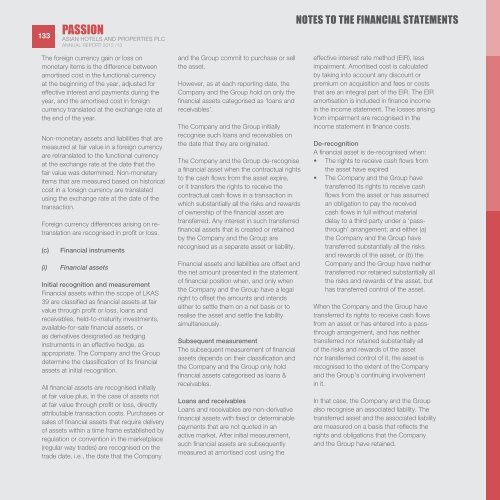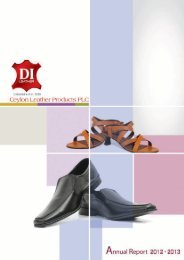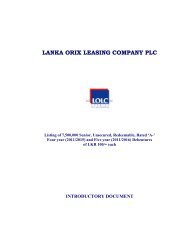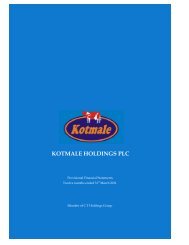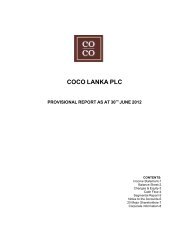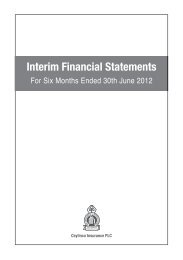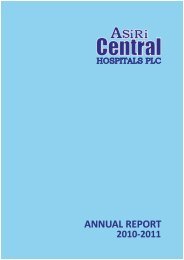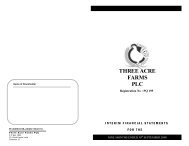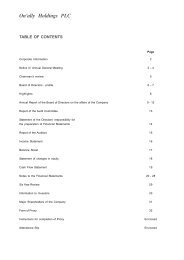ASIAN HOTELS AND PROPERTIES PLC AnnuAl RepoRt 2012/13
ASIAN HOTELS AND PROPERTIES PLC AnnuAl RepoRt 2012/13
ASIAN HOTELS AND PROPERTIES PLC AnnuAl RepoRt 2012/13
Create successful ePaper yourself
Turn your PDF publications into a flip-book with our unique Google optimized e-Paper software.
PASSION<strong>13</strong>3 <strong>ASIAN</strong> <strong>HOTELS</strong> <strong>AND</strong> <strong>PROPERTIES</strong> <strong>PLC</strong>Annual Report <strong>2012</strong> /<strong>13</strong>The foreign currency gain or loss onmonetary items is the difference betweenamortised cost in the functional currencyat the beginning of the year, adjusted foreffective interest and payments during theyear, and the amortised cost in foreigncurrency translated at the exchange rate atthe end of the year.Non-monetary assets and liabilities that aremeasured at fair value in a foreign currencyare retranslated to the functional currencyat the exchange rate at the date that thefair value was determined. Non-monetaryitems that are measured based on historicalcost in a foreign currency are translatedusing the exchange rate at the date of thetransaction.Foreign currency differences arising on retranslationare recognised in profit or loss.(c)(i)Financial instrumentsFinancial assetsInitial recognition and measurementFinancial assets within the scope of LKAS39 are classified as financial assets at fairvalue through profit or loss, loans andreceivables, held-to-maturity investments,available-for-sale financial assets, oras derivatives designated as hedginginstruments in an effective hedge, asappropriate. The Company and the Groupdetermine the classification of its financialassets at initial recognition.All financial assets are recognised initiallyat fair value plus, in the case of assets notat fair value through profit or loss, directlyattributable transaction costs. Purchases orsales of financial assets that require deliveryof assets within a time frame established byregulation or convention in the marketplace(regular way trades) are recognised on thetrade date, i.e., the date that the Companyand the Group commit to purchase or sellthe asset.However, as at each reporting date, theCompany and the Group hold on only thefinancial assets categorised as ‘loans andreceivables’.The Company and the Group initiallyrecognise such loans and receivables onthe date that they are originated.The Company and the Group de-recognisea financial asset when the contractual rightsto the cash flows from the asset expire,or it transfers the rights to receive thecontractual cash flows in a transaction inwhich substantially all the risks and rewardsof ownership of the financial asset aretransferred. Any interest in such transferredfinancial assets that is created or retainedby the Company and the Group arerecognised as a separate asset or liability.Financial assets and liabilities are offset andthe net amount presented in the statementof financial position when, and only whenthe Company and the Group have a legalright to offset the amounts and intendseither to settle them on a net basis or torealise the asset and settle the liabilitysimultaneously.Subsequent measurementThe subsequent measurement of financialassets depends on their classification andthe Company and the Group only holdfinancial assets categorised as loans &receivables.Loans and receivablesLoans and receivables are non-derivativefinancial assets with fixed or determinablepayments that are not quoted in anactive market. After initial measurement,such financial assets are subsequentlymeasured at amortised cost using thenotes to the financial statementseffective interest rate method (EIR), lessimpairment. Amortised cost is calculatedby taking into account any discount orpremium on acquisition and fees or coststhat are an integral part of the EIR. The EIRamortisation is included in finance incomein the income statement. The losses arisingfrom impairment are recognised in theincome statement in finance costs.De-recognitionA financial asset is de-recognised when:• The rights to receive cash flows fromthe asset have expired• The Company and the Group havetransferred its rights to receive cashflows from the asset or has assumedan obligation to pay the receivedcash flows in full without materialdelay to a third party under a ‘passthrough’arrangement; and either (a)the Company and the Group havetransferred substantially all the risksand rewards of the asset, or (b) theCompany and the Group have neithertransferred nor retained substantially allthe risks and rewards of the asset, buthas transferred control of the asset.When the Company and the Group havetransferred its rights to receive cash flowsfrom an asset or has entered into a passthrougharrangement, and has neithertransferred nor retained substantially allof the risks and rewards of the assetnor transferred control of it, the asset isrecognised to the extent of the Companyand the Group’s continuing involvementin it.In that case, the Company and the Groupalso recognise an associated liability. Thetransferred asset and the associated liabilityare measured on a basis that reflects therights and obligations that the Companyand the Group have retained.


